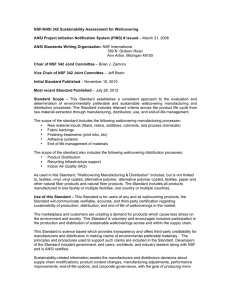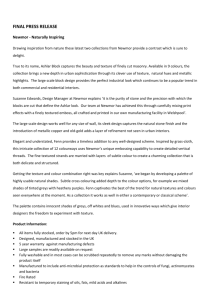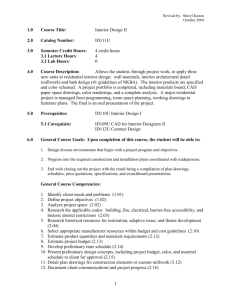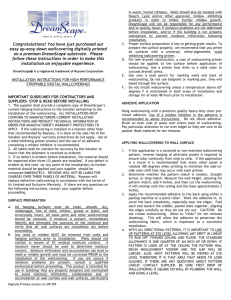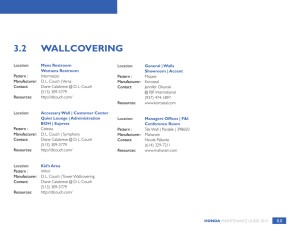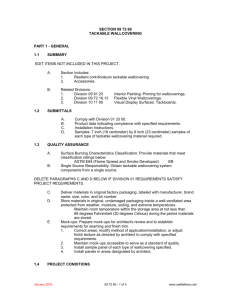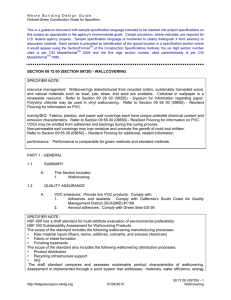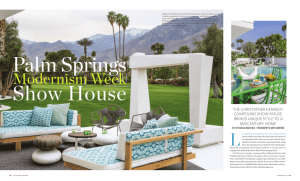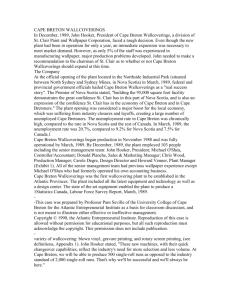************************************************************************** USACE / NAVFAC / AFCEC / NASA ...
advertisement
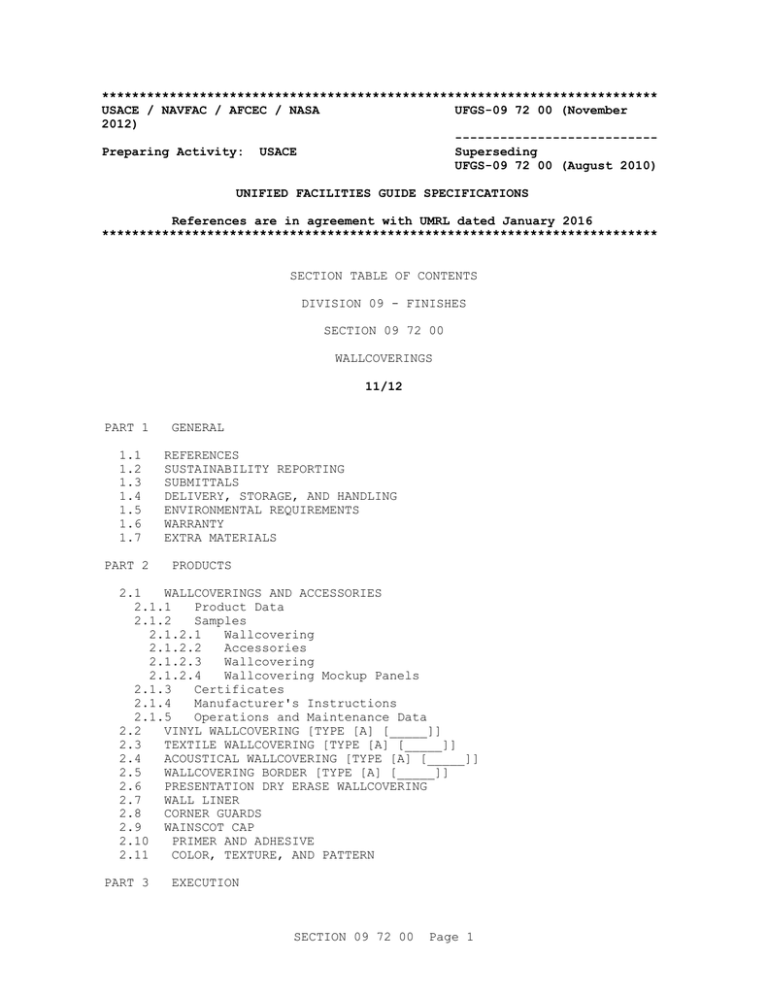
************************************************************************** USACE / NAVFAC / AFCEC / NASA UFGS-09 72 00 (November 2012) --------------------------Preparing Activity: USACE Superseding UFGS-09 72 00 (August 2010) UNIFIED FACILITIES GUIDE SPECIFICATIONS References are in agreement with UMRL dated January 2016 ************************************************************************** SECTION TABLE OF CONTENTS DIVISION 09 - FINISHES SECTION 09 72 00 WALLCOVERINGS 11/12 PART 1 1.1 1.2 1.3 1.4 1.5 1.6 1.7 PART 2 GENERAL REFERENCES SUSTAINABILITY REPORTING SUBMITTALS DELIVERY, STORAGE, AND HANDLING ENVIRONMENTAL REQUIREMENTS WARRANTY EXTRA MATERIALS PRODUCTS 2.1 WALLCOVERINGS AND ACCESSORIES 2.1.1 Product Data 2.1.2 Samples 2.1.2.1 Wallcovering 2.1.2.2 Accessories 2.1.2.3 Wallcovering 2.1.2.4 Wallcovering Mockup Panels 2.1.3 Certificates 2.1.4 Manufacturer's Instructions 2.1.5 Operations and Maintenance Data 2.2 VINYL WALLCOVERING [TYPE [A] [_____]] 2.3 TEXTILE WALLCOVERING [TYPE [A] [_____]] 2.4 ACOUSTICAL WALLCOVERING [TYPE [A] [_____]] 2.5 WALLCOVERING BORDER [TYPE [A] [_____]] 2.6 PRESENTATION DRY ERASE WALLCOVERING 2.7 WALL LINER 2.8 CORNER GUARDS 2.9 WAINSCOT CAP 2.10 PRIMER AND ADHESIVE 2.11 COLOR, TEXTURE, AND PATTERN PART 3 EXECUTION SECTION 09 72 00 Page 1 3.1 EXAMINATION 3.2 SURFACE PREPARATION 3.3 INSTALLATION 3.3.1 Wallcovering 3.3.1.1 Textile Wallcovering 3.3.1.2 Acoustical Wallcovering 3.3.1.3 Presentation Dry Erase Wallcovering Placement 3.3.2 Wall Liner 3.3.3 Corner Guards and Wainscot Cap 3.4 CLEAN-UP -- End of Section Table of Contents -- SECTION 09 72 00 Page 2 ************************************************************************** USACE / NAVFAC / AFCEC / NASA UFGS-09 72 00 (November 2012) --------------------------Preparing Activity: USACE Superseding UFGS-09 72 00 (August 2010) UNIFIED FACILITIES GUIDE SPECIFICATIONS References are in agreement with UMRL dated January 2016 ************************************************************************** SECTION 09 72 00 WALLCOVERINGS 11/12 ************************************************************************** NOTE: This guide specification covers the requirements for wallcoverings over gypsum wallboard, plaster, concrete, or masonry. Adhere to UFC 1-300-02 Unified Facilities Guide Specifications (UFGS) Format Standard when editing this guide specification or preparing new project specification sections. Edit this guide specification for project specific requirements by adding, deleting, or revising text. For bracketed items, choose applicable items(s) or insert appropriate information. Remove information and requirements not required in respective project, whether or not brackets are present. Comments, suggestions and recommended changes for this guide specification are welcome and should be submitted as a Criteria Change Request (CCR). ************************************************************************** PART 1 GENERAL ************************************************************************** NOTE: On the drawings, show: 1. Location and extent of work including dimensions of surfaces to receive wallcovering. 2. Profile of wainscot cap, when required. ************************************************************************** 1.1 REFERENCES ************************************************************************** NOTE: This paragraph is used to list the publications cited in the text of the guide specification. The publications are referred to in SECTION 09 72 00 Page 3 the text by basic designation only and listed in this paragraph by organization, designation, date, and title. Use the Reference Wizard's Check Reference feature when you add a RID outside of the Section's Reference Article to automatically place the reference in the Reference Article. Also use the Reference Wizard's Check Reference feature to update the issue dates. References not used in the text will automatically be deleted from this section of the project specification when you choose to reconcile references in the publish print process. ************************************************************************** The publications listed below form a part of this specification to the extent referenced. The publications are referred to within the text by the basic designation only. ASTM INTERNATIONAL (ASTM) ASTM C423 (2009a) Sound Absorption and Sound Absorption Coefficients by the Reverberation Room Method ASTM E84 (2015b) Standard Test Method for Surface Burning Characteristics of Building Materials GYPSUM ASSOCIATION (GA) GA 214 (2010) Recommended Levels of Gypsum Board Finish INTERNATIONAL CODE COUNCIL (ICC) ICC IBC (2012) International Building Code NATIONAL FIRE PROTECTION ASSOCIATION (NFPA) NFPA 265 (2015) Standard Methods of Fire Tests for Evaluating Room Fire Growth Contribution of Textile Coverings on Full Height Panels and Walls NFPA 286 (2015) Standard Methods of Fire Tests for Evaluating Contribution of Wall and Ceiling Interior Finish to Room Fire Growth U.S. GENERAL SERVICES ADMINISTRATION (GSA) FS CCC-W-408 (Rev D; Notices 1, 2) Wallcovering, Vinyl Coated UNDERWRITERS LABORATORIES (UL) UL 723 (2008; Reprint Aug 2013) Test for Surface SECTION 09 72 00 Page 4 Burning Characteristics of Building Materials 1.2 SUSTAINABILITY REPORTING ************************************************************************** NOTE: The bracketed items are representative of LEED material documentation and requirements that may apply to this project. These items should be edited to reflect the project requirements. ************************************************************************** Materials in this technical specification may contribute towards contract compliance with sustainability requirements. See Section 01 33 29 SUSTAINABILITY REPORTING for project[ local/regional materials,] [ low-emitting materials,] [ recycled content,] [ _____ , ][ rapidly renewable materials] and LEED documentation requirements. 1.3 SUBMITTALS ************************************************************************** NOTE: Review submittal description (SD) definitions in Section 01 33 00 SUBMITTAL PROCEDURES and edit the following list to reflect only the submittals required for the project. The Guide Specification technical editors have designated those items that require Government approval, due to their complexity or criticality, with a "G." Generally, other submittal items can be reviewed by the Contractor's Quality Control System. Only add a “G” to an item, if the submittal is sufficiently important or complex in context of the project. For submittals requiring Government approval on Army projects, a code of up to three characters within the submittal tags may be used following the "G" designation to indicate the approving authority. Codes for Army projects using the Resident Management System (RMS) are: "AE" for Architect-Engineer; "DO" for District Office (Engineering Division or other organization in the District Office); "AO" for Area Office; "RO" for Resident Office; and "PO" for Project Office. Codes following the "G" typically are not used for Navy, Air Force, and NASA projects. An "S" following a submittal item indicates that the submittal is required for the Sustainability Notebook to fulfill federally mandated sustainable requirements in accordance with Section 01 33 29 SUSTAINABILITY REPORTING. Choose the first bracketed item for Navy, Air Force and NASA projects, or choose the second bracketed item for Army projects. ************************************************************************** SECTION 09 72 00 Page 5 1.7 EXTRA MATERIALS ************************************************************************** NOTE: Extra stock of wallcovering may be required. If not, delete this paragraph. Extra stock should be based on anticipated usage. In the absence of experience data, a minimum of one linear meter for each 100 lineal meters one linear foot for each 100 linear feet installed is suggested. ************************************************************************** Provide one linear meter foot of full-width wallcovering of each pattern and color for each [100] [_____] linear meters [100] [_____] linear feet of wallcovering installed[, excluding presentation dry erase wallcovering]. Provide the same manufacturer, type, pattern, color, and lot number of extra stock as the installed wallcovering. Provide full rolls, packed for storage and marked with content, manufacturer's name, pattern and color name and number and dye lot number. Leave extra stock at the site at a location as directed by the Contracting Officer. PART 2 2.1 PRODUCTS WALLCOVERINGS AND ACCESSORIES ************************************************************************** NOTE: If more than one wallcovering type is required and specifications vary, a separate paragraph vinyl wallcovering Type, textile wallcovering Type, and/or wall covering Border Type will be used for each wallcovering type. Each wallcovering type will be designated with a letter or number symbol. Use the same symbols to key wallcovering types to locations on the drawings and Section 09 06 90 SCHEDULES FOR PAINTING AND COATING. Delete reference to type symbol if not used. Comply with NFPA 101 requirements. ************************************************************************** Provide wall coverings and accessories material designed specifically for the specified use. Furnish vinyl wallcovering and borders with a mercury, cadmium, lead, and chromium free base. Protect wallcoverings with bactericides and mildew inhibitors against microbiological and mildew growth. 2.1.1 Product Data a. Wallcovering: Submit manufacturer's discriptive data, documenting physical characteristics, flame resistance, mildew and germicidal characteristics for wallcovering. b. Accessories: Submit manufacturer's descriptive data for corner guard and wainscot cap. c. Primer and Adhesive: Submit manufacturer's descriptive data, documenting physical characteristics, mildew and germicidal characteristics. SECTION 09 72 00 Page 7 1.7 EXTRA MATERIALS ************************************************************************** NOTE: Extra stock of wallcovering may be required. If not, delete this paragraph. Extra stock should be based on anticipated usage. In the absence of experience data, a minimum of one linear meter for each 100 lineal meters one linear foot for each 100 linear feet installed is suggested. ************************************************************************** Provide one linear meter foot of full-width wallcovering of each pattern and color for each [100] [_____] linear meters [100] [_____] linear feet of wallcovering installed[, excluding presentation dry erase wallcovering]. Provide the same manufacturer, type, pattern, color, and lot number of extra stock as the installed wallcovering. Provide full rolls, packed for storage and marked with content, manufacturer's name, pattern and color name and number and dye lot number. Leave extra stock at the site at a location as directed by the Contracting Officer. PART 2 2.1 PRODUCTS WALLCOVERINGS AND ACCESSORIES ************************************************************************** NOTE: If more than one wallcovering type is required and specifications vary, a separate paragraph vinyl wallcovering Type, textile wallcovering Type, and/or wall covering Border Type will be used for each wallcovering type. Each wallcovering type will be designated with a letter or number symbol. Use the same symbols to key wallcovering types to locations on the drawings and Section 09 06 90 SCHEDULES FOR PAINTING AND COATING. Delete reference to type symbol if not used. Comply with NFPA 101 requirements. ************************************************************************** Provide wall coverings and accessories material designed specifically for the specified use. Furnish vinyl wallcovering and borders with a mercury, cadmium, lead, and chromium free base. Protect wallcoverings with bactericides and mildew inhibitors against microbiological and mildew growth. 2.1.1 Product Data a. Wallcovering: Submit manufacturer's discriptive data, documenting physical characteristics, flame resistance, mildew and germicidal characteristics for wallcovering. b. Accessories: Submit manufacturer's descriptive data for corner guard and wainscot cap. c. Primer and Adhesive: Submit manufacturer's descriptive data, documenting physical characteristics, mildew and germicidal characteristics. SECTION 09 72 00 Page 7 2.1.2 Samples 2.1.2.1 Wallcovering Submit [three][_____] samples of each indicated type, pattern, and color of wallcovering. Provide minimum 125 by 175 mm 5 by 7 inch samples of wallcovering to show pattern repeat of sufficient size. 2.1.2.2 Accessories Submit [three][_____] samples of each indicated type corner guard and wainscot cap; provide samples a minimum of 75 mm 3 inchlong. Submit [three][_____] samples of each indicated type of frame for presentation dry erase wallcovering; provide samples a minimum of 75 mm 3 inch long. [2.1.2.3 Wallcovering Provide three samples, 3 meter yards long by the width specified, of each type to be installed in the work, as required to illustrate material weight, color, shade, decorative design, and embossing when required. ][2.1.2.4 Wallcovering Mockup Panels After samples are approved, and prior to starting installation, provide a minimum 2430 by 2430 mm 8 by 8 foot wallcovering mock-up for each color and type of [vinyl][, ][fabric][, and][prestation dry erase] wallcovering, using the proposed primers and adhesives and actual substrate materials. Once approved, use the mock-up samples as a standard of workmanship for installation within the facility. Written notification to the Contracting Officer at least 48 hours prior to mock-up installation. ]2.1.3 Certificates Submit manufacturer's statement attesting that the product furnished meets or exceeds specification requirements. Date the statement after the award of the contract, state Contractor's name and address, name the project and location, and list the requirements being certified. Include these certificates: (1) Certified laboratory test reports of the physical properties for vinyl wallcovering, as specified. (2) Certificates of Compliance for UL fire hazard classification listing, as specified. (3) Certificates of Compliance for contact adhesive. 2.1.4 Manufacturer's Instructions Submit preprinted installation instructions for wallcovering and accessories, adhesives and primers. Include substrate preparation and material application in the instructions. 2.1.5 Operations and Maintenance Data a. Submit Data Package 1 in accordance with Section 01 78 23 OPERATION AND MAINTENANCE DATA. b. Submit [three][_____] copies of manufacturer's maintenance instructions SECTION 09 72 00 Page 8 for each type of vinyl wallcovering and accessory describing recommended type of cleaning equipment and materials, spotting and cleaning methods, and cleaning cycles. Instructions to also include preventative maintenance, recommended cleaning materials and precautions in the use of cleaning materials that may be detrimental to the wallcovering surface and accessories when improperly applied. 2.2 VINYL WALLCOVERING [TYPE [A] [_____]] ************************************************************************** NOTE: Select the appropriate vinyl Type designation for each wallcovering specified and delete inapplicable Types. Type selection should be based on abuse conditions and the following recommendations: Type I (Light Duty) is satisfactory for use on ceilings and light duty walls not subjected to scuffing and abrasion. This type is rarely used. Type II (Medium Duty) is satisfactory for areas subject to average traffic wear and scuffing (varies based on facility type and use); can include areas such as vestibules, corridors, lounges, offices. It may be used full height on walls or as a wainscot. Type II should be used for most vinyl wallcovering installations. Type III (Heavy Duty) is slightly more resistant to scuffing than Type II but is difficult to install and clean, and is not available from most manufacturers. Type III wallcovering is expensive and should be used only where specifically requested; may include areas that are exposed to damage by moving equipment. Some manufacturer's Type I, Type II and/or Type III wallcovering will overlap or vary slightly from the weights shown in the following paragraphs. Conversion Table: Type I Type II Type III 7 13 22 ozs/linear yd 10.5 (15) (54 inch wide) 20 33 g/sq meter ozs/sq yd (10) 237 (339) 441 g/linear meter 325 (465) 620 The Wallcovering Association WA-101 and Chemical Fabrics and Film Association CFFA-W-101-D minimum weight requirements are listed in the ozs/sq yd row SECTION 09 72 00 Page 9 in the above table, with the exception of the number shown in parenthesis. The measurements in parenthesis reflect what is currently used in the industry for Type I. The heavier weight provides a more durable product. Note that CFFA-W-101-D has now been replaced by the WA-101, but it is still being used by industry. The following formulas can be used for English to metric conversions: a. Ounces per square yard to ounces per linear yardMultiply # ounces per square yard by 1872 for 52 inches wide or 1908 for 53 inches wide or 1944 for 54 inches wide. Divide the total by 1296 to obtain per linear yard. b. Ounces per square yard to grams per square meterDivide the # ounces per square yard by 144. Multiply total by 4882 to obtain grams per square meter measurement. c. Ounces per linear yard to grams per linear meterMultiply # ounces per linear yard by 28.35. Multiply total by 1.0936 to obtain grams per linear meter measurement. Polyvinyl-fluoride (PVF) film is an extra cost. The film is designed to provide additional resistance to staining and soiling from exposure to staining reagents or chemicals, and resistance from abuse. Generally the PVF coated vinyl wallcoverings have a slightly different appearance from the standard noncoated vinyl wallcovering. The film is available in 3 thicknesses with the thin gauge material being much less expensive. Various thicknesses represent moderate (thinnest), heavy, and extreme wear (thicker) in the installation area. Consider PVF film top coating for heavy-use areas and other areas exposed to chemical reagents and staining agents such as dormitories, dining halls, cafeterias, medical facilities, and clubs. Delete PVF film when not required. ************************************************************************** Provide a vinyl coated woven or nonwoven wallcovering fabric. Conform to FS CCC-W-408 for vinyl wallcovering, [Type I (Light Duty) with a minimum total weight of [237] [339] grams/square meter [7] [10] ounces/square yard and [325][465] grams/linear meter [10.5][15] ounces/linear yard][Type II (Medium Duty) with a minimum total weight of 441 grams/square meter 13 ounces/square yard and 620 grams/linear meter 20 ounces/linear yard][Type III (Heavy Duty) with a minimum total weight of 746 grams/square meter 22 ounces/square yard and 1023 grams/linear meter 33 ounces/linear yard]. Provide width of[ 1320/1371 mm 52/54 inch] [_____]. Test vinyl wallcovering in accordance with NFPA 286 or meet the requirements of Class A when tested in accordance with ASTM E84 or UL 723. [Apply a polyvinyl fluoride (PVF) film,[ 0.00889 mm 0.00035 inch] [ 0.0127 mm 0.0005 inch] [ 0.0254 mm 0.0010 inch] thick over the face of the wallcovering. Provide a SECTION 09 72 00 Page 10 transparent (clear) film, medium gloss.] 2.3 TEXTILE WALLCOVERING [TYPE [A] [_____]] ************************************************************************** NOTE: These notes apply to both textile and acoustical wallcoverings. In accordance with NFPA 101, the use of textile materials on walls and ceilings will comply with one of the following conditions: a. Textile materials meeting the requirements of Class A when tested in accordance with ASTM E84, Standard Test Method for Surface Burning Characteristics of Building Materials, or UL 723, Standard for Test for Surface Burning Characteristics of Building Materials, using the mounting method of ASTM E2404, Standard Practice for Specimen Preparation and Mounting of Textile, Paper or Vinyl Wall or Ceiling Coverings to Assess Surface Burning Characteristcs, SHALL BE PERMITTED ON THE WALLS OR CEILINGS OF ROOMS OR AREAS PROTECTED BY AN APPROVED AUTOMATIC SPRINKLER SYSTEM. b. Textile materials meeting the requirements of Class A when tested in accordance with ASTM E84, Standard Test Method for Surface Burning Characteristics of Building Materials, or UL 723, Standard for Test for Surface Burning Characteristics of Building Materials, using the mounting method of ASTM E2404, Standard Practice for Specimen Preparation and Mounting of Textile, Paper or Vinyl Wall or Ceiling Coverings to Assess Surface Burning Characteristcs, shall be permitted on partitions that do not exceed 3/4 of the floor-to-ceiling height or do not exceed 2440 mm 8 feet in height whichever is less. c. Textile materials meeting the requirements of Class A when tested in accordance with ASTM E84, Standard Test Method for Surface Burning Characteristics of Building Materials, or UL 723, Standard for Test for Surface Burning Characteristics of Building Materials, using the mounting method of ASTM E2404, Standard Practice for Specimen Preparation and Mounting of Textile, Paper or Vinyl Wall or Ceiling Coverings to Assess Surface Burning Characteristcs, shall be permitted to extend not more than 1200 mm 48 inches above the finished floor on ceiling-height walls and ceiling-height partitions. d. Textile materials shall be permitted on walls and partitions where tested in accordance with NFPA 265. (ICC IBC is equivalent to NFPA 265.) e. Textile materials are permitted on walls, partitions, and ceilings where tested in accordance SECTION 09 72 00 Page 11 with NFPA 286. Add information on natural fibers as applicable to the project. ************************************************************************** Provide colorfast, stain, and soil resistant textile wallcovering fabricated of woven fabric with paper or acrylic backing. [Test in accordance with NFPA 265 or NFPA 286.][Meet the requirments of Class A when tested in accordance with ASTM E84 or UL 723.] Comply with or exceed the following for textile wallcovering: 2.4 Face fiber content [_____] Weave [Plain] [_____] Total Weight [_____] g/square meter ounces/square yard Width [_____] mm inch ACOUSTICAL WALLCOVERING [TYPE [A] [_____]] ************************************************************************** NOTE: See textile wallcovering notes; these notes also apply to acoustical wallcovering. ************************************************************************** Provide acoustical wallcovering fabricated of [synthetic material] [vinyl coated fabric with porous surface with fused back] [_____]. [Test in accordance with NFPA 265 or NFPA 286.] [Meet the requirments of Class A when tested in accordance with ASTM E84 or UL 723.] Comply with or exceed the following for textile wallcovering: 2.5 Total Weight [_____] g/square meter ounces/square yard Width [_____] mm inch NRC rating in accordance with ASTM C423 [_____] mm inch WALLCOVERING BORDER [TYPE [A] [_____]] Provide wallcovering border of nonwoven vinyl cellulose/polyester blend or vinyl coated strippable paper back. Comply with or exceed the following for wallcovering border: 2.6 Total Weight [_____] g/linear meter ounces/linear yard Width [_____] mm inch PRESENTATION DRY ERASE WALLCOVERING ************************************************************************** NOTE: Some products must be installed on glass SECTION 09 72 00 Page 12 reinforced cement board to achieve Class A rating. Research product to determine available features. Note that surfaces designed to be used as a projection screen are not available with 50 by 50 mm 2 by 2 inch grid pattern. ************************************************************************** Furnish presentation dry erase wallcovering that accepts dry erase markings [and is designed to be used as a projection screen] [and has a 50 by 50 mm 2 by 2 inch grid pattern]. Provide wallcovering with a minimum total weight of [678] [_____] g/square meter [20] [_____] ounces/square yard, a width of[ 1524 mm 60 inch][_____] and backing of a woven or nonwoven polyester. Test wallcovering in accordance with NFPA 286 or have a Class A flame spread rating of 0-25 and smoke development rating of 0-450 when tested in accordance with ASTM E84 or UL 723. Provide wallcovering color [selected from manufacturers standard colors] [white] [_____]. When frame is required provide [aluminum] [oak] [_____] and have a full length tray of the same material. Markings shall be removable with a felt eraser or cloth without ghosting. Provide each unit complete with an eraser, four different color compatible dry erase markers, and a 240 mlan 8 ounce bottle of liquid surface cleaner recommended by the manufacturer. 2.7 WALL LINER ************************************************************************** NOTE: Wall lining should be specified where wallcovering will be installed over masonry walls. ************************************************************************** Provide a non-woven polyester cellulose blend wall liner having a minimum weight of 125 g/square meter 3.7 ounces/square yard and a total minimum thickness of 0.33 mm 0.013 inch. Test wall liner in accordance with NFPA 286 or have a Class A flame spread rating of 0-25 and smoke development rating of 0-450 when tested in accordance with ASTM E84 or UL 723. 2.8 CORNER GUARDS ************************************************************************** NOTE: Delete references to corner guards in this specification if they are to be of the type specified in Section 10 26 00 WALL AND DOOR PROTECTION. Some projects may require both types. Coordinate locations when this occurs. ************************************************************************** Furnish[ 1 mm 0.040 inch thick corner guards and cover 20 mm 3/4 inch] [ 2 mm 0.075 inch thick corner guards 28 mm 1 1/8 inch] [2.2 mm 0.085 inch thick and cover 63 mm 2 1/2 inch] [_____] each side of corner at right angles. Provide [clear] [_____] [polycarbonate] [vinyl] [rubber] corner guards from the same color lot. 2.9 WAINSCOT CAP ************************************************************************** NOTE: A metal, vinyl, or wood wainscot cap molding will normally be required for all wainscot installations. The specification should include SECTION 09 72 00 Page 13 whether metal, vinyl, or wood molding is required. If metal or vinyl cap moldings are shown on the drawings, provisions in this paragraph should be modified accordingly. Delete inapplicable text if wainscot doesn't apply. ************************************************************************** Provide [[satin-finished extruded aluminum] [_____] wainscot cap [19][_____] mm [3/4][_____] inch high, feathered at bottom edge, with 5 mm 3/16 inch exposed face on top edge, and grooved to receive the covering][_____]. 2.10 PRIMER AND ADHESIVE ************************************************************************** NOTE: When mold is a problem in the area consider specifying mold proof primers and adhesives. ************************************************************************** Provide a type primer and adhesive recommended by the wallcovering manufacturer, containing a non-mercury based mildewcide, and complying with local indoor air quality standards. Primer shall permit removal of the wallcovering and protect the wall surface during removal. Do not damage gypsum wallboard facing paper during removal of wallcovering. Provide a strippable type adhesive. When substrate color variations show through vinyl wallcovering, provide a white pigmented primer as recommended by the wallcovering manufacturer used to conceal the variations. Provide a recommended type adhesive to install corner guards and wainscot cap by the manufacturer of the corner guards and wainscot cap. 2.11 COLOR, TEXTURE, AND PATTERN ************************************************************************** NOTE: Avoid selection of a deeply embossed pattern where frequent cleaning of wallcovering is required. Editing of color reference sentence(s) must be coordinated with the Government. Generally Section 09 06 90 Color Schedule or drawing is used when the project is designed by an Architect or Interior designer. Color should be selected from manufacturers standard colors or identified in this specification only when the project has minimal finishes. When the government directs that color be located in the drawings add a note that states: "Where color is shown as being specific to one manufacturer, an equivalent color by another manufacturer may be submitted for approval. Manufacturers and materials specified are not intended to limit the selection of equal colors from other manufacturers. The word "color" as used herein includes surface color and pattern." When more than one type, pattern or color is specified identify location and extent of work for each. SECTION 09 72 00 Page 14 ************************************************************************** USACE / NAVFAC / AFCEC / NASA UFGS-09 72 00 (November 2012) --------------------------Preparing Activity: USACE Superseding UFGS-09 72 00 (August 2010) UNIFIED FACILITIES GUIDE SPECIFICATIONS References are in agreement with UMRL dated January 2016 ************************************************************************** SECTION TABLE OF CONTENTS DIVISION 09 - FINISHES SECTION 09 72 00 WALLCOVERINGS 11/12 PART 1 1.1 1.2 1.3 1.4 1.5 1.6 1.7 PART 2 GENERAL REFERENCES SUSTAINABILITY REPORTING SUBMITTALS DELIVERY, STORAGE, AND HANDLING ENVIRONMENTAL REQUIREMENTS WARRANTY EXTRA MATERIALS PRODUCTS 2.1 WALLCOVERINGS AND ACCESSORIES 2.1.1 Product Data 2.1.2 Samples 2.1.2.1 Wallcovering 2.1.2.2 Accessories 2.1.2.3 Wallcovering 2.1.2.4 Wallcovering Mockup Panels 2.1.3 Certificates 2.1.4 Manufacturer's Instructions 2.1.5 Operations and Maintenance Data 2.2 VINYL WALLCOVERING [TYPE [A] [_____]] 2.3 TEXTILE WALLCOVERING [TYPE [A] [_____]] 2.4 ACOUSTICAL WALLCOVERING [TYPE [A] [_____]] 2.5 WALLCOVERING BORDER [TYPE [A] [_____]] 2.6 PRESENTATION DRY ERASE WALLCOVERING 2.7 WALL LINER 2.8 CORNER GUARDS 2.9 WAINSCOT CAP 2.10 PRIMER AND ADHESIVE 2.11 COLOR, TEXTURE, AND PATTERN PART 3 EXECUTION SECTION 09 72 00 Page 1 primer in accordance with the manufacturer's printed instructions. As required, use white primer when substrate color variations are visible through thin or light color wallcovering. Seal interior surfaces of exterior masonry walls to prevent moisture penetration, then prime with a wallcovering primer in accordance with the manufacturer's printed instructions. Provide masonry walls with flush joints. Test moisture content of plaster, concrete, and masonry with an electric moisture meter of a maximum five percent reading. Apply a thin coat of joint compound or cement plaster, as recommended by the wallcovering manufacturer, to the concrete and masonry walls as a substrate preparation. To promote adequate adhesion of wall lining over masonry walls, prime the walls as recommended by the wall lining manufacturer. Prime the surfaces of walls as required by the manufacturer's printed instructions to permit ultimate removal of wallcovering from the wall surfaces. Allow primer to completely dry before adhesive application. 3.3 INSTALLATION 3.3.1 Wallcovering Install wallcovering in accordance with the manufacturer's printed installation instructions. Remove glue and adhesive spillage from wallcovering face and seams with a remover recommended by the manufacturer. 3.3.1.1 Textile Wallcovering When textile wallcoverings are specified to comply with NFPA 265, NFPA 286, or ICC IBC (Section 803.5 Textile wall coverings) testing, install the wallcovering in accordance with the manufacturer's printed installation instructions for compliance with the testing using the same product mounting system, including adhesive. After the installation is complete, vacuum the fabric with a ceiling to floor motion. 3.3.1.2 Acoustical Wallcovering When acoustical wallcoverings are specified to comply with NFPA 265, NFPA 286, or ICC IBC (Section 803.5 Textile wall coverings) testing, install the wallcovering in accordance with the manufacturer's printed installation instructions for compliance with the testing using the same product mounting system, including adhesive. After the installation is complete, vacuum the fabric with a ceiling to floor motion. 3.3.1.3 Presentation Dry Erase Wallcovering Placement ************************************************************************** NOTE: Delete frame size column in schedule when wall-to-wall and floor-to-ceiling wallcovering is specified. Location of wallcovering and mounting height of framed wallcovering must be specified. Size and type of wallcovering should be specified only once in the contract documents. If more than one type is specified, clearly identify locations. Installing horizontally eliminates seams at writing height when installed at the proper height. SECTION 09 72 00 Page 16 ************************************************************************** Install presentation dry erase wallcovering [wall-to-wall and floor-to-ceiling] [_____] and horizontally on the wall. Make the first seam at[ 610 mm 24 inch above finished floor for rooms with 2440 mm 8 foot ceilings][ and ][ 760 mm 30 inch above finished floor for rooms with 2740 mm 9 foot ceilings] [_____]. Do not make seams at writing height to provide a continual, seamless writing surface.[ Provide wallcovering with an [aluminum] [oak] [_____] frame. When frame and tray are required for presentation dry erase wallcovering, install them in accordance with manufacturer's installation instructions. Upon completion of presentation dry erase wallcovering installation, clean the wallcovering surface as recommended by the manufacturer prior to first use. Provide a mounting height of framed wallcovering [as shown on the drawings] [[_____] above finished floor to top of the frame.]] Wallcovering locations are [as indicated on drawings.] [as scheduled below: Room Name and Number Wall Location Frame Size [_____] [_____] [_____] ] 3.3.2 Wall Liner ************************************************************************** NOTE: Provide reinforcing at partitions to support presentation dry erase wallcovering frames. ************************************************************************** Install wall liner over masonry walls that are to receive wallcovering. Install liner in accordance with the manufacturer's printed installation instructions. Install liner perpendicular to wallcovering to prevent overlapping of seams between liner and wallcovering. 3.3.3 Corner Guards and Wainscot Cap Install corner guards and wainscot cap [as indicated on sheet [_____]] [on all exposed corners with [wallcovering] [_____]] and in accordance with the manufacturer's printed instructions. Run corner guards from top of base to [wainscot cap] [ceiling] [_____] in a continuous length. 3.4 CLEAN-UP Upon completion of the work, clean wallcovering free of dirt, soiling, stain, or residual film. Remove and clean surplus materials, rubbish, and debris resulting from the wallcovering installation. -- End of Section -- SECTION 09 72 00 Page 17
